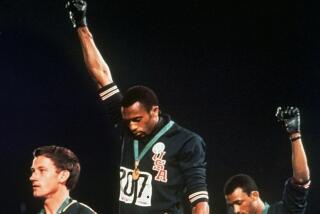Cyclist Fails Doping Test
- Share via
U.S. cyclist Tyler Hamilton, the gold medalist at the 2004 Summer Olympics in the men’s individual time trial, failed a test for blood doping at the Athens Games and could be stripped of his medal, sources with knowledge of the matter said Tuesday.
An initial test indicated the presence of someone else’s blood in Hamilton’s system, sources said, speaking on condition of anonymity because the investigation is ongoing. A follow-up test was due to be conducted Tuesday. Results were not immediately available.
Hamilton denied any wrongdoing, saying at a news conference in Switzerland: “I am 100% innocent. I worked hard for that gold medal, and it isn’t going anywhere.”
Hamilton, 33, stands to become the first U.S. athlete formally accused of a doping violation at the Athens Games. The 2004 Olympics produced a record 24 doping cases; the figure includes positive tests and rules violations such as failing to appear for a doping test.
The idea behind blood doping is simple: to get more oxygen to the muscles, which allows them to work harder. This can be done by increasing red blood cells in the system. It has been a long-standing concern at the Olympics, particularly with athletes in endurance sports such as cycling and cross-country skiing.
Assuming a blood-type match, a transfusion can work with anyone’s blood, experts said Tuesday. At the same time, transfusion can stress the heart. And an increase in the percentage of red blood cells can thicken the blood so severely it can prove fatal.
Bill Hamilton, Tyler’s father, in a telephone interview from the family home in Marblehead, Mass., dismissed any suggestion of misconduct and said his son would be cleared.
“The people who ride with him, the people who grew up with him, they know this is the least likely person to do this kind of [thing],” Bill Hamilton said. “You know what they’re trying to allege he did? Take someone else’s blood. Hello? I don’t think so.”
The Olympics had seemed to mark Tyler Hamilton’s breakthrough moment after years as a Lance Armstrong lieutenant in the Tour de France. He is slight, 5 feet 8 and perhaps 135 pounds, but fans have long appreciated his grit and spirit -- exemplified not just on the bike but in charity work for those with multiple sclerosis.
Hamilton has ridden in the Tour de France for the last several years and was known for his courageous effort in 2003, finishing fourth despite riding virtually the entire event with a broken collarbone. In 1999, 2000 and 2001, he served as one of Armstrong’s chief escorts on the U.S. Postal Service team. Armstrong’s win in July marked his sixth straight Tour de France victory.
In 2002 and 2003, Hamilton rode for CSC, a Danish team. He had been considered a prime challenger to Armstrong before the 2003 race -- but a crash during the first stage, and the broken collarbone, ended those hopes.
This year, Hamilton moved to Phonak, sponsored by a Swiss company, but he crashed again and had to withdraw.
At Athens, Hamilton won the Aug. 18 time trial, a 29.8-mile race against the clock, in 57 minutes, 31.74 seconds -- the first American to win the individual time trial in a non-boycotted Olympics.
Hamilton’s golden retriever, Tugboat, died of cancer midway through the 2004 Tour; he carried one of the dog’s tags during the winning race at the Olympics.
“To win an Olympic gold medal racing for the United States of America is the best thing in the world,” he said.
Viatcheslav Ekimov, 38, of Russia, took silver. Bronze went to Bobby Julich, 32, of Corpus Christi, Texas. Michael Rogers, 24, of Australia took fourth.
If Hamilton is disqualified, Ekimov would win gold, Julich silver, Rogers bronze.
The International Olympic Committee notified Hamilton in a letter dated Thursday that a sample taken at the Games appeared to indicate “two different red blood cell populations,” meaning his own blood and someone else’s. Hamilton’s blood was drawn Aug. 19, the day after the Olympic time trial.
Cycling’s worldwide governing body was notified of the positive test result. That apparently led to another sample being drawn this month at the Spanish Vuelta cycling event. That sample is also being reviewed for evidence of another person’s blood in Hamilton’s system.
The Athens sample was subjected to outside confirmation, for “peer review” by “outside specialists,” which took time, an official familiar with the situation said.
Blood-boosting has been a dubious part of the Olympic scene for years.
At the 1976 Summer Games in Montreal, Finnish distance running star Lasse Viren was accused of extracting blood from his system, freezing it, then -- just before racing -- allowing the frozen blood to thaw and re-injecting it into his system, thus increasing his oxygen-carrying capabilities. He denied doing so.
At the 1984 Los Angeles Summer Games, eight U.S. cyclists injected themselves with blood. Two of them became ill.
Blood doping was banned the following year. But science took cheating in a new direction, with the advent of synthetic blood-boosters such as erythropoietin, or EPO, developed for medical use to treat anemia and other ills. The arrival of the synthetics diminished the temptation among athletes to resort to transfusions, Olympic and anti-doping experts believe.
But new tests have been developed to detect athlete use of EPO and even-newer blood-boosting substances, such as darbepoetin. Such tests were used at the 2002 Winter Games in Salt Lake City. At the end of those Games, officials found blood-transfusion equipment in a house used by Austrian skiers. After an inquiry, the IOC imposed sanctions on two Austrian cross-country skiers, their coach and chiropractor.
More to Read
Go beyond the scoreboard
Get the latest on L.A.'s teams in the daily Sports Report newsletter.
You may occasionally receive promotional content from the Los Angeles Times.






